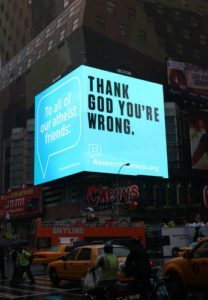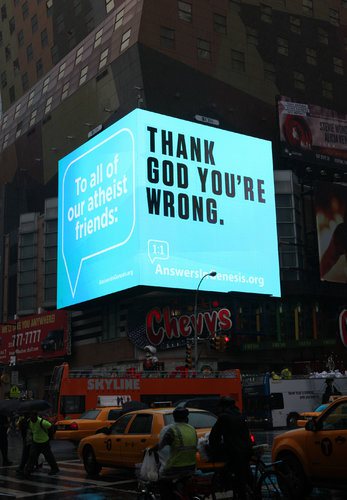Better Proselytization Through Imagination
A billboard is just that. I don’t expect a billboard, not even from Answers in Genesis (AiG), to achieve reconciliation between Christians and atheists, present a full six-day-creation message, disclaim the myth that all creationist Christians think “creation = Gospel,” or else give the whole Gospel in a sentence while also being clever and getting viewers’ attention.
Still, some seem to approach AiG’s new billboard with those expectations. My view is a bit different. Yet it’s similar to my reluctant critique last week of another favorite organization whose founder made an (at best) confusing statement about how stories help make us holy.
I want these organizations to succeed, proclaiming truth and beauty effectively to as many people as possible. In the case of AiG, I simply think there may be a better way to do that — a way that avoids tropes, cynicism, compromise or clichéd Bible quotes. Sounds incredible? Of course it does. I’m writing on the internet and it’s easy to critique without an alternative.
My suggestion, however, is not mine. AiG is already doing this and succeeding at it, and like so many Christians who have already stumbled upon excellence in sincerely held truth and imagination, I wonder if this organization’s staff simply does not know their own strengths.
Bill-boarding school
 On a Times Square (New York City) digital display, the AiG billboard simply says this:
On a Times Square (New York City) digital display, the AiG billboard simply says this:
To all of our atheist friends:
THANK GOD YOU’RE WRONG.
Which is of course followed by the name of AiG’s website.
As one long familiar with AiG, I see this billboard and say, “Huh.” As in: “What’s the point?” Apparently that’s exactly what they wanted people to think. Thus they include the website: their point is to provoke a conversation and point viewers to this evangelistic article.
These billboards are a marketing tool to drive people to the website for detailed information–and they have done that better than we hoped. We live in an Acts 17 type culture–which requires and Acts 17 approach.1
With that clear conversation-starter mission in mind, I’m left wondering two things:
1. Do some well-meaning Christian critics realize the billboard’s actual aim?
Hearts are not changed by shouting “YOU’RE WRONG” from the corner of Times Square.2
Are we sure we’re not importing from evangelical culture a “give the entire Gospel and thus change hearts immediately” approach, to apply to this ad? That is an odd expectation of a billboard. It can only do so much. And if, as Mike Duran critiques, we expect all “atheist friends” to become impressed with any Christian slogan at all, that strikes me as strange.
Only one-on-one, personal evangelism can address the complexities of human personality and the reasons people reject Christ. Only if you’re practicing Biblical discernment with another person in your life, and in front of you, can you better determine if that person would respond better to arms offering to care for them, “national repentance” for other Christians, or even an in-your-face-yet-gracious attitude that may win the other’s respect.
2. Conversely, is that the best way to reach out to non-Christians in this culture?
If I had access to such a billboard, I can think of a few more friendlier-yet-still-provocative slogans that could even generate more light and less heat — more response, less outrage.
In this case, “thank God you’re wrong” manages to resemble one of the more gracious contributions to a YouTube atheists-vs.-Christians comment war. I’m not even objecting to those wars; I only ask: why pay money to say this? You can say it on YouTube for free.
Don’t hate — subcreate
But I’ve alluded to another solution, still matching AiG’s goals, that could be more helpful.
This solution presupposes that the Creation Museum in southern Ohio / northern Kentucky is a fantastic attraction, an artful triumph, an incarnated example of God-exalting creativity that most Christians say they’d love to see but haven’t often seen. The place is immaculate, well-run, and bristling with creativity — the moving dinosaurs, museum motion pictures, dazzling HD planetarium, soundtracks, actors, dioramas, set design, informational signs, and animatronic apostles3. I’ll put it this way: you may be the most hardcore “theistic evolution,” six-day-creationists-ruined-faith-for-the-rest-of-us advocate, but if you love well-done, creative Christian art, I’d still encourage a visit to the museum.
Here’s my question, then: if the Creation Museum is such a legitimately inspiring attraction, winning admiration even from critics, why not spread that creative sense a little? They’ve already been doing this locally with billboards advertising the museum. But I’m not talking of tourism promotion — only the same sensibility. Include a provocative phrase, perhaps, but show something. Show an image of something beautiful. Something that images this:
The Bible describes God as eternal […] all-powerful […] Creator of the whole universe […]4
Let’s show more creativity. Just as the Creation Museum shows. Think “incarnationally.” Appeal, as the best evangelists did, to Biblical truth shown in imagination. This applies whenever we share God’s Story, whether its beginning, middle, or end — because often we can’t share it all at once. Even if we do, it’s only a start. Only the Spirit changes hearts.
- Ken Ham in a Facebook reply, Oct. 17, 2013. ↩
- Responding to Things like AiG’s Billboard, Chuck McKnight, undated post, BeingFilled.com. ↩
- And like most art, this catches criticism. The apostle Paul would not have looked like that!, etc. Possible dog-bites-man headline: “Progressive” Christians criticize “fundamentalist” museum’s art design. ↩
- Thank God You’re Wrong, AnswersinGenesis.org. ↩












































I don’t really mind it. It looks like it comes from the same culture of snarky, passive-aggressive hostility by which atheists also criticize us in the public square. Sometimes that public hostility can be truly harmful, but I think Christians can engage in it lovingly.
I think it does portray God’s glory to a small degree, because it follows the “rules” of its own particular kind of medium. It’s an effective piece of information design. In contrast, if it said “ATHEISTS ARE GOING TO HELL” or even “JESUS LOVES ATHEISTS,” then the criticism of being tacky, artificial evangelism would be valid. As it is now, I don’t think it’s deliberate evangelism at all, which is part of the reason that it works.
I agree with you on all that, but I think your definition of imagination might be somewhat narrow. Neither storytelling nor visual arts are the only ways to employ God-given creativity, even if they are the most obvious and abstract ways. Can’t the skillful communication of an edgy message through creative use of color, shape, and typography glorify God, too? If it can’t, that would suggest that all Christian designers could only use decorative, gothic, “Arts and Crafts” style designs in informational media.
I definitely agree with all that. Yet I also see even more benefit from the creative, “this is who we are, unashamed of it, and watch us work for God’s glory” approach. Because AiG is already doing that, and making local inroads and being such a great witness for proactive Christian presence in the world, I think it might help if they took more of that approach in their nationwide outreaches.
I’m not a communications or marketing major, but I’m sure there’s some way that ads can start a conversation….but I think starting is as far as you can get without a person.
I’ve seen few, if any comments that critiqued that message in the fact that it didn’t give the whole gospel message in a nutshell. I did see critiques that it didn’t convey the spirit of the gospel. But the only place I saw this discussed much at length is on Mike’s blog. So I may have just missed them.
But I have run across that attitude among Christians evaluating a Christian novel. It’s like if you don’t have a list of events happening–sinner in need of saving, spiritual mentor who knows it all, some form of gospel presentation, sinner converted–it isn’t a Christian book. A Christian novel can’t simply plant seeds, or encourage the faithful, or explore a moral dilemma.
I think most people wouldn’t expect a billboard to convey a whole gospel message. What they designed it to do, gain traffic at their site, I’m sure it did in some measure. Question is, was it effective at reaching and convincing atheist and agnostics to take a serious look at the concept of God and who He is?
One, the billboard probably generated traffic, but I’d be interested to know (and I doubt they do know themselves) what percentage of their traffic was Christians who agreed with them, and what percentage was real atheist and agnostics? My gut tells me the atheist and agnostics who follow the link to the site will do so in hopes of refuting whatever logic they find, not to sincerely investigate.
Two, I looked at their site and video. If I were agnostic or an atheist, none of that would be very convincing. What they will hear is, “We have it right. Trust us.” That’s not going to convince very many people. The fact is, they don’t trust we have it right. First you have to convince them of that before you can use it in an argument.
Three, maybe God will, can, and has used this to convert some people. After all, He used Jonah’s poor excuse of an attempt to convert a whole giant city. His message as he walked through the city basically said, “Get ready. God’s coming, and you’re all going to Hell.” Maybe only God knows how many this actually changed minds and started them seeking God. And only God knows how many potential converts this may have turned away.
Four, as I stated on Mike’s blog, this billboard doesn’t open up to real dialog as much as draw fighting lines and put people on the defensive. Never a good idea if you want real dialog with them, if that’s the goal.
Five, upon going to their site, I saw no opportunity for dialog. Just being preached at. And from a perspective I’m not in full agreement with as a Christian.
Six, related to four, it portrays Christians as more about proving we’re right than about engaging in respectful dialog to convince them of the truth.
Seven, it simply doesn’t convince them of the truth of Christianity because it starts on the wrong foot. Jesus didn’t say they will know you are Christians by your snark.
Could the Holy Spirit use this to save someone through engaging in further dialog? I believe He can. He’s good at taking our feeble three fish and five loaves and doing something great with them. Could this have given God something more to work with? I think I hear you saying yes, and I agree with you.
It does, however, parallel the debate in Christian fiction as to what is more effective evangelism. Subtle, preachy, in-your-face, or sneaky.
Mostly agreed, brother. Which is why the Creation Museum takes a far better approach thanks to its creativity and professionalism, and simply by existing as a proactive, safe (yet challenging), and non-reactionary “incarnate” place.